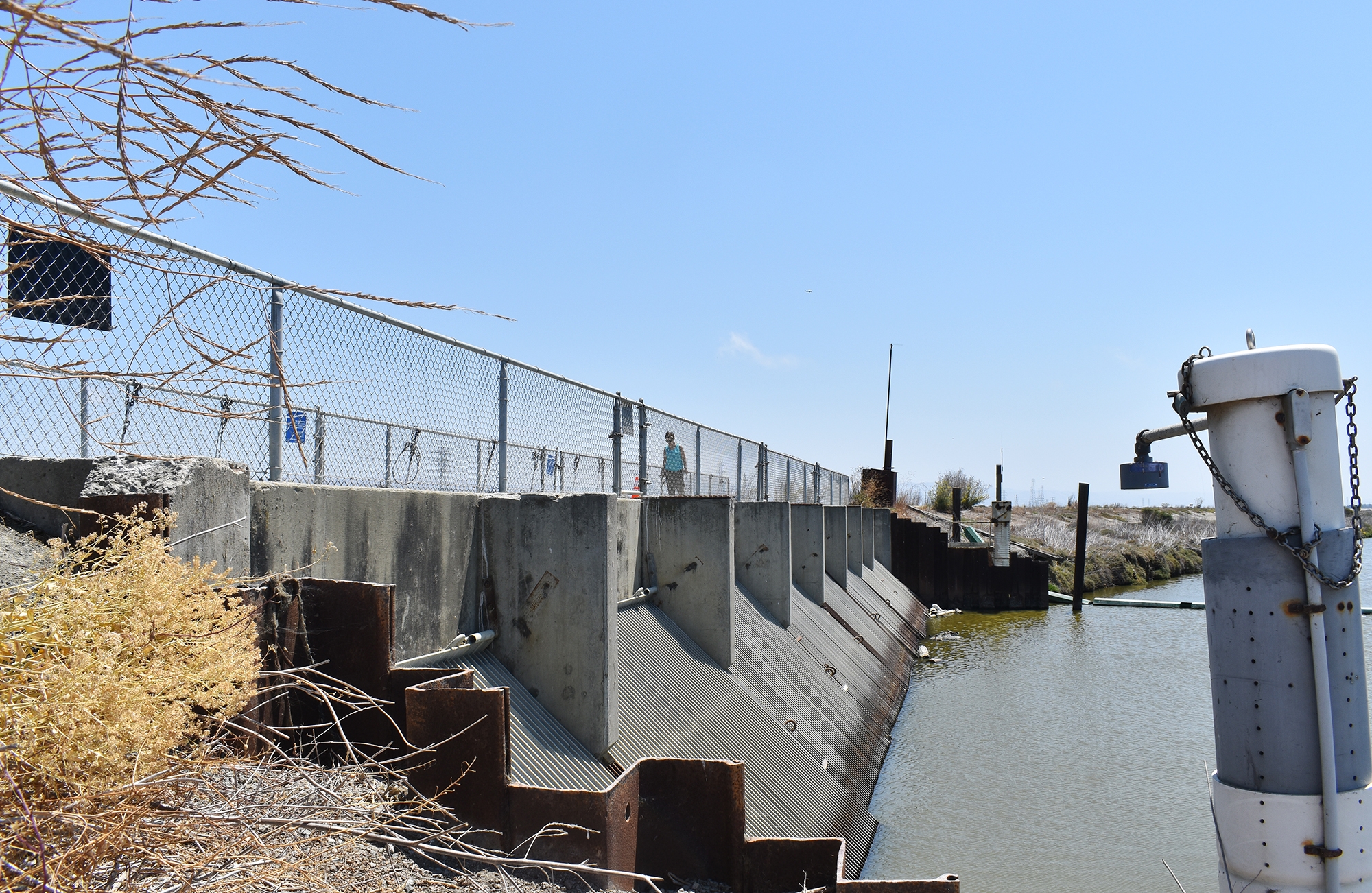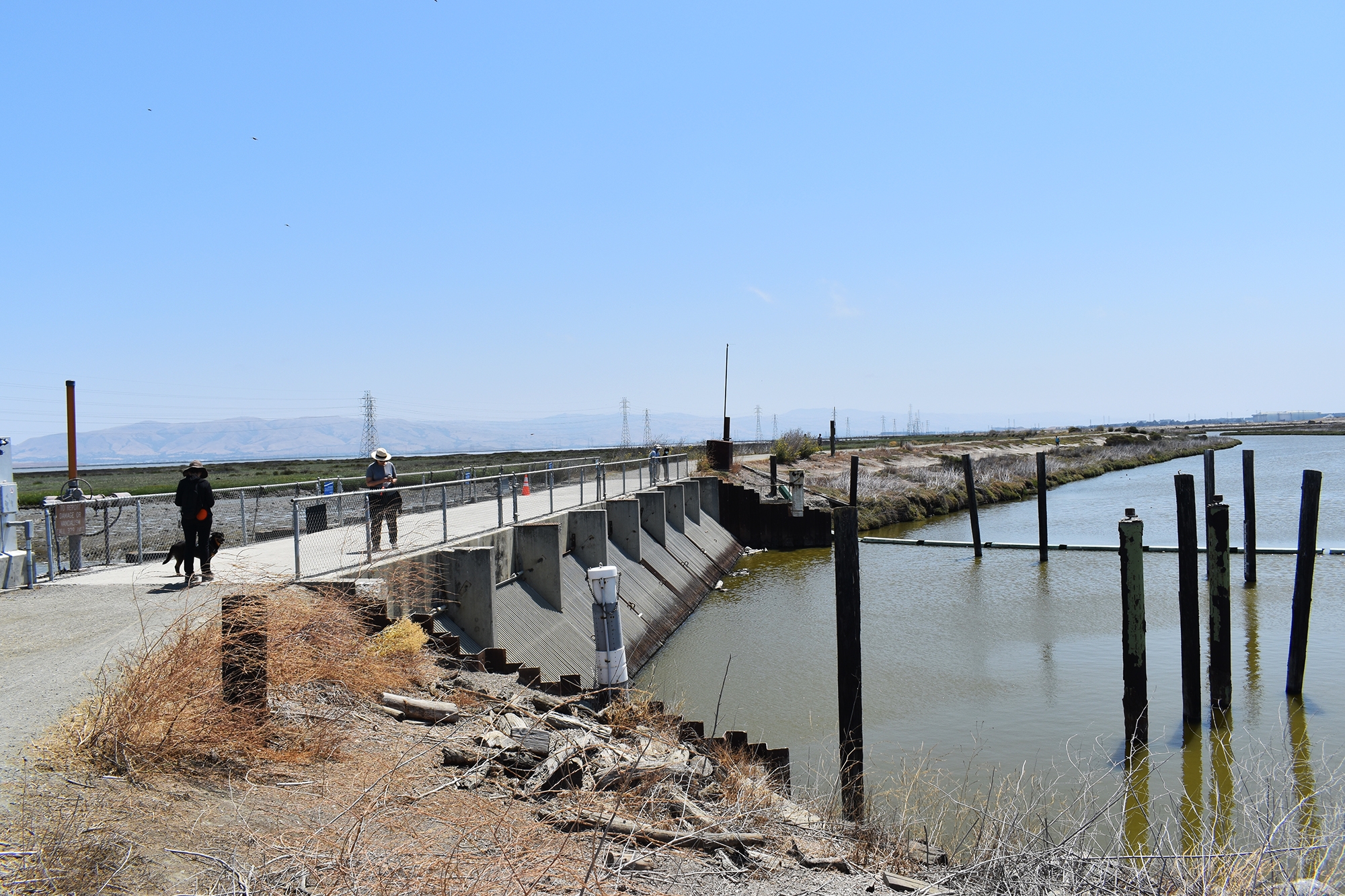Seeking to regulate water flow at local creeks and bolster protection from sea level rise, Valley Water is setting the stage for a four-year construction project in the Palo Alto Baylands that is expected to cost close to $40 million and that will temporarily close a popular trail.
The project, which is slated to kick off in November, calls for replacement of a structure that was installed in 1957 east of the Palo Alto Municipal Airport and the Baylands Nature Preserve. The 16-gate structure along the Adobe Creek Loop trail stores floodwater in the Palo Alto Flood Basin and releases it into the bay when water levels rise above the bay's tidal elevation. When water surface in the bay is higher than in the basin, the gates are shut to prevent the Baylands from getting inundated and to protect U.S. Highway 101 and surrounding parcels.
The new structure will also include a motorized sluice gate that will allow the city to regulate the water quality within the flood basin.
Valley Water, a water agency formerly known as the Santa Clara Valley Water District, is still in the process of acquiring all the needed permits for the construction project. But if all goes as planned, the agency will begin work on constructing a new levee for the structure possibly as early as November, according to Robert Yamane, an associate civil engineer with Valley Water who is managing the project.
The district's contractor would then begin constructing the new tide-gate structure in fall 2022, with the goal of completing it in the fall or winter of 2025, according to a timeline that Valley Water presented to Palo Alto's Parks and Recreation Commission on June 22.
In recent years, the existing structure at the north end of the flood basin has been showing signs of wear and tear, with fragments of concrete breaking off, marine growth covering its gates and corrosion damaging its concrete steel reinforcement damage, according to a Valley Water study. While a 2017 assessment by structural engineers suggested that minor upgrades to the structure may suffice to keep it fully functional for the next few years, a subsequent inspection that the district commissioned the following year recommended complete replacement.
Yamane said the existing tide-gate structure has "aged beyond its service life." The district's analysis notes that the new one will "reduce flood risks in areas surrounding the Palo Alto flood basin and in the lower reaches of Matadero, Adobe, and Barron creeks and protect wildlife and aquatic habitats in the flood basin."
"We want to maintain or provide better level of service for flood protection for Matadero, Barron and Adobe creeks, as well as to protect parcels and Highway 101 that could have coastal flooding if the existing structure were to completely fail," Yamane said at the meeting, shortly before the parks commission voted unanimously to support a park-improvement ordinance for the replacement of the tide-gate structure.
While Valley Water is spearheading the project, Palo Alto is a key partner. Staff from the Community Services Department has been working with the water district and has endorsed the district's effort, which includes removing the 113-foot-long structure that is currently in place and the levee that supports it and construction of a 132-foot-long tide gate structure. A report from the Community Services Department notes that the current tide-gate structure is "deteriorating" and that the existing trail on top of the levee would be smoothened and strengthened as part of the replacement.
"If the replacement Structure is not constructed, future degradation of the existing Structure will occur and would eventually require closure of the Trail for an unknown duration of time," the report states.
Much like the existing flood-gate structure, the new one will include 15 "passive" gates that rely on gravity to regulate water levels and one motorized sluice gate, which allows the city to manage the water levels and maintain water quality in the flood basin. The new structure will also include water level sensors and a SCADA (supervisory control and data acquisition) system to "improve flexibility and efficiency for the City's sluice gate operations" and enable remote operations of the sluice gate.
While the district has yet to determine the final costs of the project, Yamane pegged the price tag at about $39 million, which includes staff work and the repairs that the district made in 2017. Some of the funding is expected to come from Valley Water's Watersheds and Stream Stewardship Fund (known as Fund 12), though the district is also hoping to obtain funding through Proposition 68, a bond that state voters passed in 2018 to support parks and water projects, according to Valley Water's planning study. Palo Alto is also expected to contribute some funding, though the exact amount remains undetermined.
The sensitive nature of the Baylands habitat adds to the project's costs and construction challenges. Work will be limited to five months per year to avoid interfering with the breeding season of the California Ridgway's rail, an endangered species. This requires contractors to move their equipment in and out of the area every year until the project is complete.
"It's the multiyear construction that really drives up the cost," Yamane said.
He also noted that because the current tide-gate structure serves a "critical function," the district can't remove it until the new one is in place.
"A large amount of water can come in if we have a 100-year storm, so we cannot cut off the existing structure until the new structure is built and put into service," he said.
The parks commission unanimously supported moving ahead with the replacement. Its biggest concern was the temporary loss of access to Adobe Creek Loop Trail, a popular loop for pedestrians and bicyclists. Commissioner Keith Reckdahl was one of several commissioners who urged Valley Water and city staff to make sure that the materials used in the new trail can accommodate bicyclists, including those using road bikes.
"They're not going to be happy right now because they're losing all these seasons, but that's just something we'll have to do," Reckdahl said. "I'm really interested in making the surface usable for road bikes, because it is heavily used by road bikes."
Reckdahl also urged Valley Water to do ample public outreach so that Baylands visitors aren't surprised by construction.
"When something is coming like this, people take it better when they know it's coming," he said.




Comments
Registered user
Green Acres
on Jul 13, 2021 at 2:31 pm
Registered user
on Jul 13, 2021 at 2:31 pm
Any bets on how quickly the SCADA system will be hacked and Palo Alto held hostage to flooding if no Bitcoin payment is made?
Registered user
Another Palo Alto neighborhood
on Jul 13, 2021 at 4:30 pm
Registered user
on Jul 13, 2021 at 4:30 pm
Any chance of while they are at it in getting some proper restrooms out there. The portapotties are not very hygienic or fun to use.
Registered user
Barron Park
on Jul 13, 2021 at 9:44 pm
Registered user
on Jul 13, 2021 at 9:44 pm
As a cyclist, I hope that the Adobe Creek Trail (and other trails in Palo Alto's baylands) will be paved - perhaps as part of this project. I don't enjoy riding on pitted paths and over rough gravel. Given how popular Mountain View's paved paths in their baylands are for cyclists, I think many would agree with me.